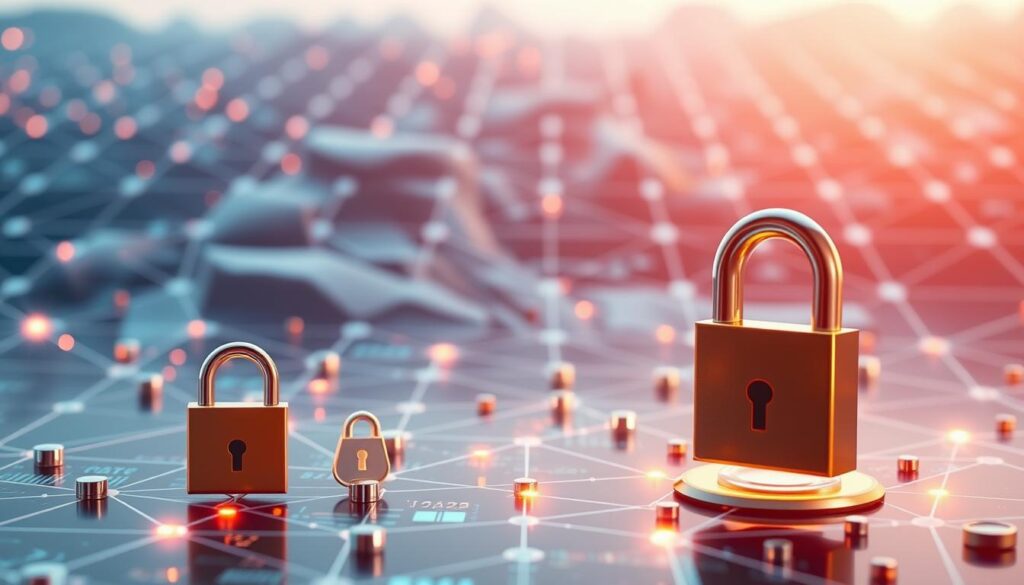Now Reading: NFT Scam Fraud Prevention Awareness Guide
- 01
NFT Scam Fraud Prevention Awareness Guide
NFT Scam Fraud Prevention Awareness Guide

The digital landscape has witnessed an extraordinary transformation with the emergence of unique digital tokens. These innovative assets represent ownership of special items like artwork, music, and collectibles. The market for these digital certificates has exploded in recent years.
From modest beginnings with just a few million dollars in sales during 2019, the sector grew to over $2 billion by 2021. This rapid expansion has unfortunately attracted dishonest individuals seeking to exploit the system. Many participants have suffered significant financial losses as a result.
Understanding how to protect your valuable digital holdings has become absolutely essential. Whether you’re a creator, collector, or investor, having the right knowledge can make all the difference. This comprehensive resource provides crucial insights into safeguarding your interests.
Our guide covers everything from basic technology understanding to advanced protective measures. You’ll learn to recognise common deceptive tactics and implement effective security strategies. We’ll also explore wallet security and working with trusted industry professionals.
Key Takeaways
- Digital tokens represent ownership of unique items like artwork and music
- The market has experienced massive growth from 2019 to 2021
- This expansion has attracted dishonest actors seeking to exploit participants
- Protecting your digital holdings is essential for all market participants
- This guide provides comprehensive coverage of security measures
- Learn to identify common deceptive tactics and implement protection strategies
- Understand wallet security and collaboration with trusted experts
Understanding the NFT Landscape
The blockchain era has introduced innovative methods for verifying authenticity through unique digital certificates. These special tokens represent ownership of distinctive items in the digital realm.
What Are NFTs and How They Work
Non-fungible tokens are digital assets that prove ownership of unique content. Unlike interchangeable cryptocurrencies, each token possesses distinct characteristics that cannot be replicated.
Built on blockchain technology, these assets use smart contracts to authenticate ownership. The unique metadata associated with each item distinguishes it from other tokens in circulation.
Several factors determine an asset’s worth in this space. Creator reputation, item uniqueness, and market demand all contribute to perceived value among collectors.
Evolution of Digital Assets in the Blockchain Era
These unique tokens first gained popularity within gaming environments and virtual worlds. Their application has since expanded across numerous creative industries.
Today’s marketplace ecosystem supports diverse transaction methods including auctions and direct sales. This evolution reflects growing adoption across digital art, music, and collectible spaces.
Identifying Common NFT Fraud Tactics
Digital ownership platforms face significant challenges from various deceptive schemes designed to separate buyers from their funds. Understanding these tactics is crucial for anyone participating in the digital asset space.

Malicious actors employ several methods to exploit collectors. Recognising these patterns helps participants avoid financial losses.
Fake NFTs and Counterfeit Listings
Some individuals create counterfeit versions of valuable digital assets. They sell these forgeries as genuine items to unsuspecting buyers.
These deceptive listings often appear nearly identical to legitimate ones. Buyers may pay premium prices for assets that hold no real value.
Pump and Dump Schemes and Rug Pulls
Artificial demand creation represents another common tactic. Groups coordinate to inflate prices before selling their holdings.
Project abandonment schemes involve creators making promises then disappearing. The Frosties incident demonstrated how this can result in substantial financial harm.
| Deceptive Practice | How It Works | Warning Signs | Potential Impact |
|---|---|---|---|
| Counterfeit Listings | Copying genuine assets for resale | Unverified creator accounts | Loss of investment funds |
| Price Manipulation | Artificial hype generation | Sudden price spikes | Asset value collapse |
| Project Abandonment | Creator disappearance after sales | Anonymous team members | |
| Phishing Attacks | Fake giveaway promotions | Unverified website links | Complete wallet draining |
Social media platforms often serve as channels for these deceptive promotions. The Rare Bears incident showed how phishing attacks can lead to substantial losses.
Always verify authenticity before committing funds. Research creators and examine transaction histories carefully.
NFT Scam Fraud Prevention Awareness Strategies
Developing robust defence mechanisms involves coordinating authentication protocols with real-time monitoring systems. This strategic approach helps businesses and collectors safeguard their valuable digital assets effectively.
Implementing Proactive Detection Measures
Businesses must prioritise authentication processes that verify creator identities and ownership history. Thorough due diligence checks ensure only legitimate digital assets appear on platforms.
Real-time marketplace monitoring allows for immediate intervention when suspicious activity occurs. Advanced detection tools using pattern recognition can identify problematic listings before they cause harm.
Leveraging Industry Threat Intelligence
Staying informed about emerging trends provides crucial security information for all participants. Active engagement with artists and collectors creates valuable intelligence networks.
User feedback channels transform communities into active defence systems. Collaboration between platforms helps identify new threats through shared information.
This collective approach significantly reduces exposure to problematic situations while maintaining positive experiences for users interacting with digital assets.
Evaluating Blockchain and Smart Contract Security
Blockchain infrastructure provides the foundational security layer for digital ownership certificates through its distinctive architectural properties. This technology creates a trustworthy environment for recording and verifying asset ownership.
The Role of Immutability and Transparency
Blockchain’s immutable nature ensures that once data is recorded, it cannot be altered or deleted. This permanence creates a reliable chain of custody for digital assets.
Transparency allows all participants to verify ownership history and transaction details. Decentralised ledgers significantly reduce risks of tampering with digital certificate data.

However, this immutability presents challenges. Smart contracts and associated links cannot be updated after deployment. This can cause persistent security vulnerabilities in the system.
How Smart Contracts Mitigate Fraud Risks
Smart contracts automate transaction terms without requiring intermediaries. They execute agreements automatically when predetermined conditions are met.
This automation reduces opportunities for manual intervention in transactions. Robust contract logic ensures secure processing of digital asset exchanges.
| Security Feature | Benefit | Limitation |
|---|---|---|
| Immutability | Prevents data tampering | Cannot fix deployed errors |
| Transparency | Public verification possible | Requires third-party storage |
| Smart Contracts | Automates secure transactions | High minting costs on some chains |
| Private Key Control | Direct ownership management | Permanent loss if compromised |
Ownership of these digital items is controlled through private keys. Any loss or unauthorised access to these keys can result in permanent asset loss. Understanding both advantages and limitations helps participants make informed security decisions, as explored in recent blockchain security research.
Authentication and Identity Verification Best Practices
Establishing reliable verification protocols represents the cornerstone of secure digital asset transactions. These measures protect both creators and collectors from impersonation risks.
Proper authentication ensures that digital items maintain their intended value. It also builds trust throughout the marketplace ecosystem.
Robust Identity Proofing Methods
Businesses should implement comprehensive identity verification systems. Document validation and biometric checks confirm participant legitimacy.
Multiple authentication layers create essential security checkpoints. This approach verifies creator identities before listing any digital items.

Web authentication processes examine associated metadata thoroughly. They validate ownership history and examine digital signatures.
Verifying Artist Credibility and Ownership
Investigating project teams helps distinguish legitimate creators. Even anonymous developers typically maintain active community engagement.
Cross-referencing blockchain records confirms actual ownership rights. This prevents fraudulent resale attempts by unauthorised parties.
| Verification Method | Primary Purpose | Implementation Level | Effectiveness Rating |
|---|---|---|---|
| Document Verification | Confirm legal identity | Business platform | High |
| Biometric Authentication | Prevent impersonation | User access | Very High |
| Blockchain History Check | Validate ownership chain | Asset listing | Essential |
| Social Media Analysis | Assess creator engagement | Project evaluation | Moderate-High |
By implementing these authentication best practices, users significantly reduce risks when acquiring digital items. Proper verification protects both financial investment and personal information.
For comprehensive guidance on securing your digital holdings, explore our detailed resource on protecting your valuable assets.
Conducting Due Diligence and Marketplace Monitoring
Vigilant market participation requires careful evaluation before any trading activity begins. Proper research helps distinguish legitimate opportunities from problematic situations.

Businesses and collectors should verify creator authenticity thoroughly. This includes checking artistic backgrounds and previous work history.
Assessing Marketplace Trustworthiness
Continuous platform monitoring identifies unusual trading patterns quickly. Regular checks help spot artificial demand creation tactics.
Watch for these warning signs when evaluating any digital asset project:
- Unrealistic profit promises that ignore market risks
- Poorly developed project roadmaps with missing technical details
- Payment methods that bypass standard cryptocurrency requirements
- Inactive project teams with minimal community engagement
Some promoters use celebrity endorsements to create false credibility. Others employ limited-time offers to pressure quick decisions.
Understanding these principles helps participants assess genuine project value. For comprehensive guidance on evaluating digital collections, explore our resource on identifying authentic opportunities.
Implementing Advanced Fraud Detection Tools
Advanced detection systems represent the next frontier in securing digital ownership transactions. These intelligent frameworks leverage cutting-edge technology to identify suspicious patterns before they cause harm.
Platforms can now deploy sophisticated algorithms that analyse multiple data points simultaneously. This proactive approach protects both businesses and legitimate users from various deceptive practices.
Utilising Machine Learning and Behavioural Biometrics
Machine learning models examine user behaviour patterns across digital marketplaces. They identify anomalies in transaction history and marketplace activity that may indicate problematic situations.
Behavioural biometrics technology analyses how individuals interact with platforms. This creates unique digital fingerprints that help distinguish genuine users from automated systems.
These systems can detect different types of suspicious activity with remarkable accuracy. They flag unusual patterns for human review while allowing normal transactions to proceed smoothly.
Real-Time Analysis of Transaction Patterns
Real-time monitoring tools provide immediate alerts when suspicious patterns emerge. They track transaction flows across multiple channels simultaneously.
This continuous surveillance helps platforms respond quickly to emerging threats. The technology analyses metadata associated with digital assets to identify potential issues.
| Detection Technology | Primary Function | Accuracy Level | Response Time |
|---|---|---|---|
| Machine Learning Algorithms | Pattern recognition | Very High | Near real-time |
| Behavioural Biometrics | User authentication | Extremely High | Immediate |
| Transaction Analysis | Anomaly detection | High | Real-time |
| Metadata Examination | Content verification | Moderate-High | Rapid |
These advanced tools significantly reduce exposure to deceptive practices. They maintain security without disrupting legitimate user experiences.
Securing Wallets and Custodial Services
Proper storage solutions form the bedrock of digital asset protection. Your choice of wallet and how you manage access directly impacts the safety of your holdings.
This involves careful key management and selecting trusted service partners. These two elements work together to create a robust defence.
Best Practices for Private Key Management
Ownership of digital items is controlled exclusively by private keys. Losing these keys or having them stolen means permanent loss of your assets.
Always store your recovery phrases offline in multiple secure locations. Never share these details with anyone under any circumstances.
For significant crypto holdings, use a hardware wallet. This keeps your keys isolated from online threats.
Be extremely cautious of links promoting new digital drops or giveaways. Malicious sites can drain your funds if you connect your wallet.
Partnering with Reputable Wallet Providers
Businesses should guide users toward secure wallets and custodial services. Partnering with established providers adds a vital security layer.
Look for solutions offering multi-factor authentication and encryption. These features significantly reduce unauthorised access risks.
Consider using separate wallets for different activities. One can hold long-term assets, while another interacts with new projects.
| Wallet Type | Primary Use | Security Level | Key Management |
|---|---|---|---|
| Hardware Wallet | Long-term storage | Very High | Offline (Cold) |
| Mobile Wallet | Regular transactions | Moderate-High | Device-based |
| Custodial Service | Ease of use | Provider-dependent | Third-party |
| Web Extension | Marketplace interaction | Moderate | Browser-based |
By implementing these strategies, you create a strong barrier against theft. Your valuable digital items remain under your control.
Collaborating with Industry Experts and Regulatory Bodies
Working together with established platforms and regulatory authorities strengthens the entire digital ownership space. This collaborative approach creates multiple layers of protection for everyone involved.
Building networks where companies share information about suspicious activities creates collective intelligence. This helps identify emerging threats before they become widespread problems.
Engaging with Trusted Platforms
Partnering with reputable marketplaces provides essential security benefits. These platforms often offer comprehensive customer support services that operate around the clock.
Some security providers maintain extensive databases of known malicious actors. This allows quick identification of problematic transactions involving digital tokens.
When platforms work together, they can spot patterns across different projects. This collective approach helps protect the broader crypto ecosystem.
Navigating Legal and Compliance Issues
Businesses must take regulatory requirements seriously. Failing to prevent problematic sales can lead to significant legal consequences.
Regulatory bodies like the SEC face challenges keeping pace with rapid market evolution. This makes proactive compliance efforts even more important for companies that sell nfts.
Financial authorities have warned about misleading promotions on social media. These often feature false celebrity endorsements or unrealistic promises.
Allocating resources for compliance should be seen as essential operational spending. Staying informed about evolving regulations helps businesses avoid penalties that could damage demand for their project.
Conclusion
Protecting your valuable digital holdings represents an evolving challenge requiring adaptive strategies. The comprehensive guidance throughout this resource emphasises that security extends far beyond simple transaction protection.
Negative experiences can rapidly damage market credibility and business prospects. Operational disruptions and strained customer support further compound initial financial impacts.
Regulatory compliance remains essential for sustainable participation in digital asset trading. Businesses must view security as an ongoing commitment rather than a one-time setup.
By implementing the layered approach outlined—from understanding blockchain technology to securing wallets—participants significantly reduce risks. This protects both individual collectors and the broader ecosystem’s health.
Continuous education about emerging threats ensures confident engagement with legitimate opportunities. Your vigilance contributes to building a trustworthy marketplace where genuine innovation can thrive.
FAQ
What is the best way to protect my digital collectibles from theft?
The most effective protection involves using a secure, non-custodial wallet and never sharing your private keys or seed phrase. Enable all available security features, such as two-factor authentication, and double-check all website URLs to avoid phishing attempts.
How can I tell if a non-fungible token project is legitimate?
Conduct thorough research. Check the credibility of the creators, examine the smart contract’s code if possible, and look for an active, authentic community on social media. Be wary of projects that promise guaranteed high returns or exhibit rushed, low-effort marketing.
What should I do if I suspect I’ve encountered a counterfeit listing?
Do not engage with the listing. Report it immediately to the marketplace’s support team. Verify the official artist or project channels to confirm the authenticity of the listing before considering any purchase.
Are there specific tools to help analyse trading activity for suspicious patterns?
A> Yes, several platforms and analytical tools utilise machine learning to monitor transaction behaviour on the blockchain. These can help identify unusual activity, such as the rapid inflation and subsequent collapse of an asset’s price, which is characteristic of a pump and dump scheme.
What role does blockchain technology play in preventing fraud?
The inherent transparency and immutability of a blockchain provide a public record of ownership and transactions. This makes it more difficult for scammers to alter records or falsely claim ownership of a digital asset, adding a layer of security to the ecosystem.
How important is customer support when choosing a platform to trade on?
Extremely important. A platform with responsive, knowledgeable customer support can be crucial for resolving issues quickly, such as reporting suspicious listings or recovering access to an account. It is a key indicator of a marketplace’s trustworthiness.












